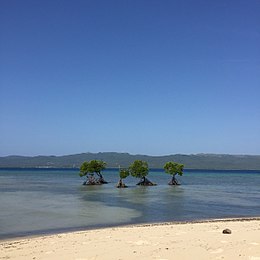Alibijaban is a small island located off the southeastern coast of Bondoc Peninsula in the island of Luzon. It belongs administratively to the municipality of San Andres, Quezon province, and is coterminous with the barangay of the same name. With a population of 1,738 inhabitants in 2020, it is the smallest of seven barangays in San Andres.[1]
 The coast of Alibijaban facing Bondoc Peninsula | |
 | |
| Geography | |
|---|---|
| Location | 3.6 kilometers (2.2 mi) off San Andres, Quezon |
| Coordinates | 13°21′11″N 122°43′7″E / 13.35306°N 122.71861°E |
| Adjacent to | Ragay Gulf |
| Administration | |
| Region | Calabarzon |
| Province | Quezon |
| Municipality | San Andres |
The island is known for its pristine mangrove forest and coral reefs. It is also visited for its white sandy beaches and rich bird life.[2] Its mangrove forest which covers approximately 140 hectares (350 acres) of the island's central and northern portions is protected under the National Integrated Protected Areas System as a wilderness area called the Alibijaban Island Wilderness Area.[3] 225 hectares (560 acres) of waters surrounding it have also been declared a marine protected area known as the Alibijaban Fish Sanctuary.[4]
Description
editAlibijaban is located in the southwestern end of Ragay Gulf approximately 3.6 kilometres (2.2 mi) from the mainland of Bondoc Peninsula. It is roughly 4.6 kilometres (2.9 mi) from north to south, and 1.3 kilometres (0.81 mi) from east to west at its widest point. It is a low-lying island surrounded by a fringing reef which is interspersed with seagrass beds near the shore. The island's central and northern interior are dominated by mangrove wilderness, with most of the population concentrated on two sitios on the island's western and southwestern coast facing San Andres and Bondoc Peninsula. Its coastal formations include sandy beaches and rocky shores, particularly in its northeastern side.[4]
The island is accessible via motorized banca from the port of San Andres. It is 330 kilometres (210 mi) southeast of Manila via the Pan-Philippine Highway and Bondoc Peninsula Road.[2]
Conservation
editAlibajaban has some of the most undisturbed mangrove wilderness in the Philippines. It hosts at least 22 mangrove species and 14 species of birds, including the Tabon scrubfowl, white-collared kingfisher, jungle crow, black-naped oriole, Philippine collared dove, Asian glossy starling, chestnut munia, Philippine pied fantail, common emerald dove, black-crowned night heron, common snipe.[2] It also supports a number of fruit bats and monitor lizards. Since the establishment on the island of a wilderness protected area in 1981, the Community Environment and Resources Office (CENRO) under the Department of Environment and Natural Resources and Provincial Government of Quezon now administers the area.[3][2]
The island also has the most diverse marine habitat in the region of Ragay Gulf. It is home to at least 30 genera of hard coral dominated by Porites, Montipora and Acropora. Its adjacent waters are visited by whale sharks, manta rays, and pawikans (marine turtles).[4] The passage of a municipal ordinance in 2006 prohibited all kinds of fishing in the area.[4]
Tourism
editAlibijaban is an emerging backpacker destination. It's fine white sand beach and mangrove forest are few of the reasons why backpackers visit the island. The activities to do include: beach bumming, camping, boating, and snorkeling.[5]
References
edit- ^ "Highlights of the Philippine Population 2015 Census of Population". 2015 Census of Population and Housing. Philippine Statistics Office. Retrieved 27 May 2016.
- ^ a b c d "Alibijaban Island Wilderness Area". Department of Environment and Natural Resources. Archived from the original on 3 February 2016. Retrieved 11 November 2015.
- ^ a b "Proclamation No. 2151, s. 1981". Official Gazette of the Republic of the Philippines. Retrieved 11 November 2015.
- ^ a b c d Atlas of Philippine Coral Reefs. Goodwill Trading Co., Inc. 2002. ISBN 9789711202507. Retrieved 11 November 2015.
- ^ "Alibijaban Island: A DIY Travel Guide". Freedom Wall. Retrieved 27 April 2016.
External links
edit- Media related to Alibijaban at Wikimedia Commons
